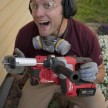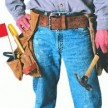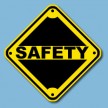If There’s Lead Paint Dust ~ Think HEPA
Lead Paint Dust and HEPA Requirements
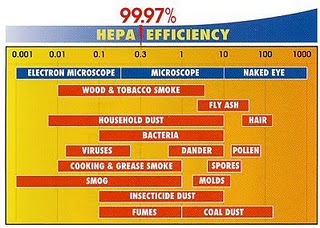
Image: prostar-mechanical.com/air/Greentek/micron_chart.jpg
More children become lead poisoned from leaded dust than any other form of exposure.
Removing lead dust can protect children, pregnant women and household occupants.
The problem with lead dust is it’s so small; it cannot be seen by the naked eye so special cleaning methods are needed to make sure you get rid of all the harmful dust. For this reason it is important not to create more dust than necessary, especially when we’re talking lead dust.
Most houses built before 1978 have lead paint in them. Common renovation activities like sanding, cutting, and demolition can create hazardous lead dust and chips by disturbing lead-based paint, which can be harmful to adults and children.
To protect against this risk, on April 22, 2008, EPA issued a rule requiring the use of lead-safe practices and other actions aimed at preventing lead poisoning.
Under the rule, beginning in April 2010, contractors performing renovation, repair and painting projects that disturb lead-based paint in homes, child care facilities, and schools built before 1978 must be certified and must follow specific work practices to prevent lead contamination.
I just received my EPA certification and am now considered a “certified renovator.” Over the next month or two I will be posting several articles on this new law and the “best practices” for dealing with renovations and this dangerous dust.
All contractors should follow these three simple procedures:
- Contain the work area.
- Minimize dust.
- Clean up thoroughly.
Cleaning The Job Site Is A Necessary Evil!
Keeping the job site clean is the first step!
Renovators must consider where lead dust can settle and deal accordingly. Here are a few procedures to consider:
1 Remove all objects from the work area or cover them with plastic sheeting with all seams and edges sealed.
2. Close and cover all ducts opening in the work area with taped-down plastic sheeting.
3. Close windows and doors in the work area. Doors must be covered with plastic sheeting.
4. Cover the floor surface with taped-down plastic sheeting in the work area a minimum of six feet beyond the perimeter of surfaces undergoing renovation or a sufficient distance to contain the dust, whichever is greater.
5. Use precautions to ensure that all personnel, tools, and other items, including the exteriors of containers of waste, are free of dust and debris when leaving the work area.
6. After the renovation has been completed, the renovator must clean the work area until no dust, debris or residue remains.
VACUUMING UP THE DUST:
Vacuuming with a regular shop-vacuum or household vacuum will not remove the very small lead dust particles in the home that can poison children.
Unfortunately most vacuums are not designed to collect the fine dust. Much of the dust that is picked up is blown back out the exhaust of the vacuum, which resettles in the house on flat surfaces, furniture, and floors where children become exposed.
When dealing with Lead paint dust I do not recommend using a regular Shop-Vacuum. Instead use a HEPA vacuum.
What does HEPA mean?
HEPA is an acronym for “High Efficiency Particulate Air. “
What is a HEPA vacuum and how do I use it?
A HEPA vacuum is a very useful tool available to contractors and homeowners to clean lead-contaminated surfaces in the home.
HEPA vacuum filters are different from regular shop-vacuum filters by being able to trap very fine dust particles [up to 0.3 microns] of dust particles that are too small to see. They are also very expensive in comparison.
HEPA vacuums are also beneficial for family members with allergies. The best kind to get for the purposes of lead dust control is one that has different attachments for different surfaces and is a canister style with a long hose for reaching high places. It should also have a beater bar (agitator head) attachment for carpets and rugs.
Many items in the home should be cleaned using a HEPA vacuum, including ceilings, walls, floors, windows, interior and exterior window sills, doors, heating, ventilation, and air conditioning equipment (heating diffusers, radiators, pipes, vents), fixtures of any kind (light, bathroom, kitchen), built-in cabinets, and appliances.
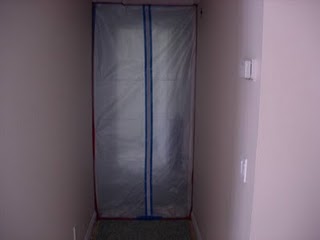
Image: allprorestorationhelp.com/Zip_Wall.JPG
CLEANING METHOD [STEP 1]
To most effectively remove lead dust from any room in the house it’s best to keep it contained during the work phase. Do this by closing all doors, windows and sealing off HVAC vents. Install plastic sheeting at all openings and doorways not sealed .
Start in the room farthest from the main entrance/exit door so that dirt is not tracked into areas that have already been HEPA cleaned.
Collect all paint chips and debris, and seal it in a heavy-duty bag.
Remove and dispose of protective sheeting as waste. Leave the plastic on the doors up until your finished.
Vacuum from room to room working toward the main exit door and finish there. If only one room is being HEPA vacuumed, work from the farthest area from the door and finish at the doorway.
Clean all objects and surfaces in the work area and within two feet of the work area in the following manner:
In each room, begin HEPA vacuuming at the top of each room (ceiling, walls, and top shelves) and work down to the floor.
Do every inch of the windows, especially in the window trough or well where the movable part of the window rests when it is closed.
Use the special attachments to clean hard-to-reach areas. The needle-nosed tool should be used to clean baseboards and cracks in the floor boards.
Brush attachments should be used for walls and woodwork.
Move the HEPA vacuum slowly and carefully over surfaces so it can pick up all of the lead dust.
If you own a HEPA vacuum, change the bag and filter using the manufacturer’s instructions. Changing them outside will prevent lead dust from resettling on floors and furniture.
CLEANING METHOD: [Step 2]
After using the HEPA vacuum follow these steps.
Clean non-carpeted or upholstered surfaces by wet washing with a soapy detergent and rinsing with fresh water; damp mop all floors then after surfaces have dried, use the HEPA vacuum a final time.
A note about wet washing — make a soapy solution using a small amount of soap; use a disposable paper towel to dip into the soapy solution and wipe the surface clean; throw away the towel and start again with a new one until the whole area is clean; follow up with a new paper towel wet with fresh water and wipe the surface again to get the soap residue and any remaining dust off of the surface.
Clean one room at a time. Remove the plastic sheeting at the doorways and clean area.




